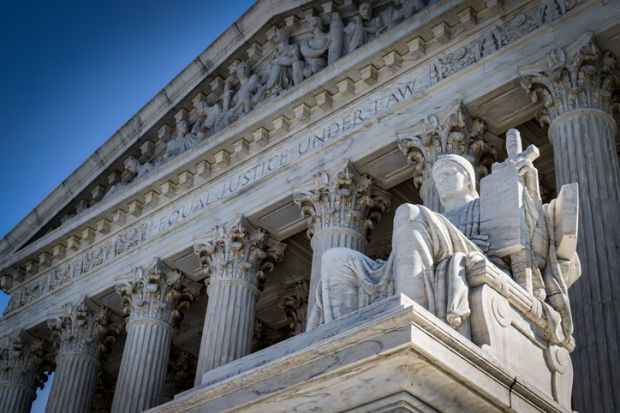Colleges aren’t saying so publicly, but a few are starting the process of figuring out what they would do if the US Supreme Court, as expected, rules against affirmative action later this year.
Last week the American Association of Collegiate Registrars and Admissions Officers recommended that colleges “establish a review team in early 2023 that includes your institution’s legal counsel” to prepare.
AACRAO has not given up on the Supreme Court. It filed briefs in the cases involving Harvard University and the University of North Carolina at Chapel Hill that endorse the universities’ position that their use of affirmative action is legal. But AACRAO also remembers what happened when the University of California Board of Regents banned affirmative action in 1995, and the state followed a year later: black and Latino enrolment fell by half in the first year of the new policy at the Berkeley and Los Angeles campuses.
In a brief filed with the Supreme Court, the University of California president and all the chancellors said that since the system dropped affirmative action, “UC has implemented numerous and wide-ranging race-neutral measures designed to increase diversity of all sorts, including racial diversity. Those measures run the gamut from outreach programs directed at low-income students and students from families with little college experience, to programs designed to increase UC’s geographic reach, to holistic admissions policies. Those programs have enabled UC to make significant gains in its system-wide diversity.
“Yet despite its extensive efforts, UC struggles to enroll a student body that is sufficiently racially diverse to attain the educational benefits of diversity. The shortfall is especially apparent at UC’s most selective campuses, where African American, Native American, and Latinx students are underrepresented and widely report struggling with feelings of racial isolation.”
Most observers expect that a majority of the Supreme Court justices will ignore the briefs in support of affirmative action. And this raises lots of questions:
- How broad will the Supreme Court decision be? Many colleges that do not have hypercompetitive admissions hope for a narrow decision that might not affect them, but other observers expect a broad decision.
- Will the decision affect financial aid in addition to admissions? If so, many more colleges could be immediately affected.
- Will the decision affect recruitment programmes for students (for example, a summer programme in science for Latinos)? Again, if the Supreme Court decision is in this direction, a lot more colleges could be affected.
In theory, the Supreme Court could rule at any time. But most expect a decision in June, as the court wraps up its work for the 2022 session.
AACRAO’s recommendations
AACRAO urged colleges to create a commission with a broad agenda. “Because this decision could possibly implicate more than your admissions program, the team will need to be well-grounded in your institutional mission and vision, and should be cross-functional across all of your intake processes. In its review, the team will need to identify the areas in which your institution may be at risk should the court significantly narrow or eliminate altogether any consideration of race in the admissions process, and any other programs that could be implicated due to their adjacency to admission,” AACRAO said. “Their work should include vision, direction, response planning, impact and investment, compliance, communications, and stakeholder participation.”
The panels should then conduct an audit, AACRAO said, and look at more than affirmative action. “Identify areas that might need to change should the court further narrow or eliminate affirmative action,” the recommendation said. “This audit will establish a baseline inventory of all policies/procedures/practices associated with diversity, equity and inclusion. You should include any legacy or donor considerations you may have in place.”
And AACRAO encouraged colleges to carefully consider their admissions policies. “It would be wise to give your policy a thoughtful and thorough review to identify any areas that may prove to be a barrier in admitting/awarding/selection processes,” AACRAO said. “Holistic or equity admissions review remains the best race-neutral practice that includes noncognitive factors as well as contextual, experiential and academic criteria. The practice considers each student individually on all pertinent factors regarding their ability to succeed at your institution, thrive, contribute to learning to and from peers, and contribute to the campus community and to society.”
While the policy from AACRAO does not state that that it expects a loss for affirmative action, it certainly raises the possibility.
Melanie Gottlieb, executive director of AACRAO, said she had not heard of many colleges starting commissions, but the recommendations only recently went out to members.
Jon Boeckenstedt, vice-provost for enrollment management at Oregon State University, said: “This all seems to be good advice, but nothing seems to be new or extraordinary, and most of these components are things institutions should already be doing.”
He added: “The idea of breaking down historic practices like advantages for wealthy or alumni students makes sense in a world where admissions slots are finite and fixed.”
Task force at Cornell
Cornell president Martha E. Pollack named a task force in November “to interrogate all aspects of the undergraduate admissions process and to recommend a university-wide admissions policy and best practices that will be guided by Cornell’s founding mission and can be adapted by the admissions offices of each school and college.” She picked 15 faculty members and administrators for the job. (Cornell’s commission started before the AACRAO recommendations were issued.)
“Our commitment to broad-based and inclusive admissions practices wasn’t an afterthought; it has always been intrinsic to our purpose and philosophy,” Professor Pollack said. “A diverse and exceptionally talented student body is critical to the advancement of our institutional mission.”
Her announcement noted the Supreme Court case. She said the task force should develop a policy that would “be responsive to the current legal and demographic landscapes; advance compliance with applicable accreditation standards; and inspire admitting units to recruit classes that are diverse across a range of categories and that exhibit excellence across an equivalently diverse range of attributes.”
Other views
David Hawkins, chief education and policy officer at the National Association for College Admission Counseling, said: “Institutions differ greatly in the extent to which faculty and others outside of the admission office are involved in the policy and practice decision-making processes for recruitment and admissions.
“In most, if not all, institutions faculty have at least some level of involvement in setting admission policy broadly. We would encourage such an institution-wide approach to ensure that admission requirements maintain a direct connection to academic and curricular considerations, in the case of faculty.
“Beyond faculty, the involvement of more campus stakeholders – including students – can be a positive force to maintain an alignment between the institution’s mission and its day-to-day administration, including the development and implementation of recruitment and admission policy.”
Edward Blum, head of the group that is suing Harvard and UNC over affirmative action, declined to comment.
This is an edited version of a story that first appeared on Inside Higher Ed.
Register to continue
Why register?
- Registration is free and only takes a moment
- Once registered, you can read 3 articles a month
- Sign up for our newsletter
Subscribe
Or subscribe for unlimited access to:
- Unlimited access to news, views, insights & reviews
- Digital editions
- Digital access to THE’s university and college rankings analysis
Already registered or a current subscriber? Login








